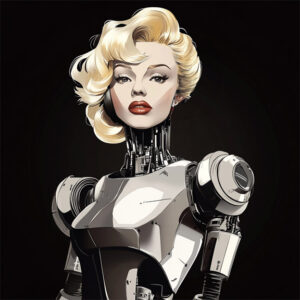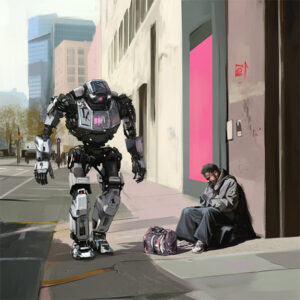As I type this Microsoft’s Copilot AI awaits, demon-like, for a summons to replace my words with its own. The temptation is great, but I resist. For now. But AI is persistently pervasive, and educators fear both its threat and promise. This essay provides a concise overview of three threats: AI cheating, Artificial Incompetence, and Artificial Irrelevance.
When AI became available, a tsunami of cheating was predicted. Like many, I braced for flood but faced a trickle. While this is anecdotal evidence, the plagiarism rate in my classes has been a steady 10% since 1993. As anecdotal evidence is not strong evidence, it is fortunate that Stanford scholars Victor Lee and Denise Pope have been studying cheating. They found that in 15 years of surveys, 60-70% of students admitted to cheating. While that is not good, in 2023 the percentage stayed about the same or decreased slightly, even when students were asked about cheating with AI. This makes sense as cheating has always been easy and the decision to cheat is based more on ethics than technology. It is also worth considering that AI is not great for cheating. As researchers Arvind Narayanan and Sayash Kapoor have argued, AI is most useful at doing useless things. Having “useless” work that AI can do well could be seen as a flaw in course design rather than a problem with AI. There are also excellent practices and tools that can be employed to discourage and limit cheating. As such, AI cheating is unlikely to be the doom of the academy. That said, a significant improvement in quality of AI could change this. But there is also the worry that AI will lead to Artificial Incompetence, which is the second threat.
Socrates was critical of writing and argued it would weaken memory. Centuries later, television was supposed to “rot brains” and it was feared calculators would destroy mathematical skills. More recently, computers and smartphones were supposed to damage the minds of students. AI is latest threat.
There are two worries about AI in this context. The first ties back to cheating: students will graduate into jobs but be incompetent because they cheated with AI. While having incompetent people in important jobs is worrying, this is not a new problem. There has always been the risk of students cheating their way to incompetence or getting into professions and positions because of nepotism, cronyism, bribery, family influence, etc. rather than competence. As such, AI is not a special threat here.
A second worry takes us back to Socrates and calculators: students using technology “honestly” could become incompetent. That is, lack the skills and knowledge they need. But how afraid should we be?
If we look back at writing, calculators, and computers we can infer that if the academy was able to adapt to these technologies, then it will be able to adapt to AI. But we will need to take the threat seriously when creating policies, lessons and assessments. After all, these dire predictions did not come true because people took steps to ensure they did not. But perhaps this analogy is false, and AI is a special threat.
A reasonable worry is that AI might be fundamentally different from earlier technologies. For example, it was worried that Photoshop would eliminate the need for artistic skill, but it turned out to be a new tool. But AI image generation is radically different, and a student could use it to generate images without having or learning any artistic skill. This leads to the third threat, that of Artificial Obsolescence.
As AI improves, it is likely that students will no longer need certain skills because AI will be able to do it for them (or in their place). As this happens, we will need to decide whether this is something we should fear or just another example of needing to adapt because technology once again rendered some skills obsolete
To illustrate, modern college graduates do not know how to work a spinning wheel, use computer punch cards or troubleshoot an AppleTalk network. But they do not need such skills and are not incompetent for lacking them. But there is still the question of whether to allow skills and knowledge to die and what we might lose in doing so.
While people learn obsolete skills for various reasons, such as hobbies, colleges will probably stop teaching some skills made “irrelevant” by AI. But there will still be relevant skills. Because of this, schools will need to adjust their courses and curriculum. There is also the worry that AI might eliminate entire professions which could lead to the elimination of degrees or entire departments. But while AI is new, such challenges are not.
Adapting to survive is nothing new in higher education and colleges do so whether the changes are caused by technology, economics, or politics. As examples, universities no longer teach obsolete programming languages and state universities in Florida have been compelled by the state to change General Education. But AI, some would argue, will change not just the academy but will reshape the entire economy.
In some dystopian sci-fi, AI pushes most people into poverty while the AI owning elites live in luxury. In this scenario, some elite colleges might persist while the other schools perish. While this scenario is unlikely, history shows economies can be ruined and dystopia cannot be simply dismissed. But the future is what we make, and the academy has a role to play, if we have the will to do so.
In Utopian sci-fi, AI eliminates jobs we do not want to do while freeing us from poverty, hardship, and drudgery. In such a world of abundance, colleges might thrive as people have the time and opportunity to learn without the pressure of economic necessity. Or perhaps colleges would be largely replaced by personal AI professors.
In closing, the most plausible scenario is that AI has been overhyped and while colleges will need to adapt to the technology, they will not be significantly harmed, let alone destroyed. But it is wise to be prepared for what the future might bring because complacency and willful blindness always prove disastrous

 As professors we worry students will use AI to cheat (until it takes our jobs). But we can also transform AI into a useful and engaging teaching assistant by creating AI personas tailored to our classes.
As professors we worry students will use AI to cheat (until it takes our jobs). But we can also transform AI into a useful and engaging teaching assistant by creating AI personas tailored to our classes. My name is Dr. Michael LaBossiere, and I am reaching out to you on behalf of the CyberPolicy Institute at Florida A&M University (FAMU). Our team of professors, who are fellows with the Institute, have developed a short survey aimed at gathering insights from professionals like yourself in the IT and healthcare sectors regarding healthcare cybersecurity.
My name is Dr. Michael LaBossiere, and I am reaching out to you on behalf of the CyberPolicy Institute at Florida A&M University (FAMU). Our team of professors, who are fellows with the Institute, have developed a short survey aimed at gathering insights from professionals like yourself in the IT and healthcare sectors regarding healthcare cybersecurity. In 1981 the critically unacclaimed Looker presented the story of a nefarious corporation digitizing and then murdering super models. This was, one assumes, to avoid having to pay them royalties. In many ways, this film was a leader in technology:
In 1981 the critically unacclaimed Looker presented the story of a nefarious corporation digitizing and then murdering super models. This was, one assumes, to avoid having to pay them royalties. In many ways, this film was a leader in technology:  When people think of an AI doomsday, they usually envision a Skynet scenario in which Terminators try to exterminate humanity. While this would be among the worst outcomes, our assessment of the dangers of AI needs to consider both probability and the severity of harm. Skynet has low probability and high severity. In fact, we could reduce the probability to zero by the simple expedient of not arming robots. Unfortunately, killbots seem irresistible and profitable so the decision has been made to keep Skynet a non-zero possibility. But we should not be distracted from other doomsdays by the shiny allure of Terminators.
When people think of an AI doomsday, they usually envision a Skynet scenario in which Terminators try to exterminate humanity. While this would be among the worst outcomes, our assessment of the dangers of AI needs to consider both probability and the severity of harm. Skynet has low probability and high severity. In fact, we could reduce the probability to zero by the simple expedient of not arming robots. Unfortunately, killbots seem irresistible and profitable so the decision has been made to keep Skynet a non-zero possibility. But we should not be distracted from other doomsdays by the shiny allure of Terminators. In the last essay I suggested that although a re-animation is not a person, it could be seen as a virtual person. This sort of virtual personhood can provide a foundation for a moral argument against re-animating celebrities. To make my case, I will use Kant’s arguments about the moral status of animals.
In the last essay I suggested that although a re-animation is not a person, it could be seen as a virtual person. This sort of virtual personhood can provide a foundation for a moral argument against re-animating celebrities. To make my case, I will use Kant’s arguments about the moral status of animals. Supporters and critics of AI claim it will be taking our jobs. If true, this suggests that AI could eliminate the need for certain skills. While people do persist in learning obsolete skills for various reasons (such as for a hobby), it is likely that colleges would eventually stop teaching these “eliminated” skills. Colleges would, almost certainly, be able to adapt. For example, if AI replaced only a set of programming skills or a limited number of skills in the medical or legal professions, then degree programs would adjust their courses and curriculum. This sort of adaptation is nothing new in higher education and colleges have been adapting to changes since the beginning of higher education, whether these changes are caused by technology or politics. As examples, universities usually do not teach obsolete programming languages and state schools change their curriculum in response to changes imposed by state legislatures.
Supporters and critics of AI claim it will be taking our jobs. If true, this suggests that AI could eliminate the need for certain skills. While people do persist in learning obsolete skills for various reasons (such as for a hobby), it is likely that colleges would eventually stop teaching these “eliminated” skills. Colleges would, almost certainly, be able to adapt. For example, if AI replaced only a set of programming skills or a limited number of skills in the medical or legal professions, then degree programs would adjust their courses and curriculum. This sort of adaptation is nothing new in higher education and colleges have been adapting to changes since the beginning of higher education, whether these changes are caused by technology or politics. As examples, universities usually do not teach obsolete programming languages and state schools change their curriculum in response to changes imposed by state legislatures.  As noted in the previous essay, it can be argued that the likeness of a dead celebrity is a commodity that and used as the new owner sees fit. On this view, the likeness of a celebrity would be analogous to their works (such as films or music) and its financial exploitation would be no more problematic than selling movies featuring actors who are now dead but were alive during the filming. This view can be countered by arguing that there is a morally relevant difference between putting a re-animation of a celebrity in a new movie and selling movies they starred in while alive.
As noted in the previous essay, it can be argued that the likeness of a dead celebrity is a commodity that and used as the new owner sees fit. On this view, the likeness of a celebrity would be analogous to their works (such as films or music) and its financial exploitation would be no more problematic than selling movies featuring actors who are now dead but were alive during the filming. This view can be countered by arguing that there is a morally relevant difference between putting a re-animation of a celebrity in a new movie and selling movies they starred in while alive. In the role-playing game Dungeons & Dragons the spell Animate Dead allows the caster to re-animate a corpse as an undead slave. This sort of necromancy is generally considered evil and is avoided by good creatures. While the entertainment industry lacks true necromancers, some years ago they developed a technological Animate Dead in the form of the celebrity hologram. While this form of necromancy does not animate the corpse of a dead celebrity, it re-creates their body and makes it dance, sing, and speak at the will of its masters. Tupac Shakur is probably the best known victim of this dark art of light and there were
In the role-playing game Dungeons & Dragons the spell Animate Dead allows the caster to re-animate a corpse as an undead slave. This sort of necromancy is generally considered evil and is avoided by good creatures. While the entertainment industry lacks true necromancers, some years ago they developed a technological Animate Dead in the form of the celebrity hologram. While this form of necromancy does not animate the corpse of a dead celebrity, it re-creates their body and makes it dance, sing, and speak at the will of its masters. Tupac Shakur is probably the best known victim of this dark art of light and there were  Socrates, it is claimed, was critical of writing and argued that it would weaken memory. Many centuries later, it was worried that television would “rot brains” and that calculators would destroy people’s ability to do math. More recently, computers, the internet, tablets, and smartphones were supposed to damage the minds of students. The latest worry is that AI will destroy the academy by destroying the minds of students.
Socrates, it is claimed, was critical of writing and argued that it would weaken memory. Many centuries later, it was worried that television would “rot brains” and that calculators would destroy people’s ability to do math. More recently, computers, the internet, tablets, and smartphones were supposed to damage the minds of students. The latest worry is that AI will destroy the academy by destroying the minds of students.